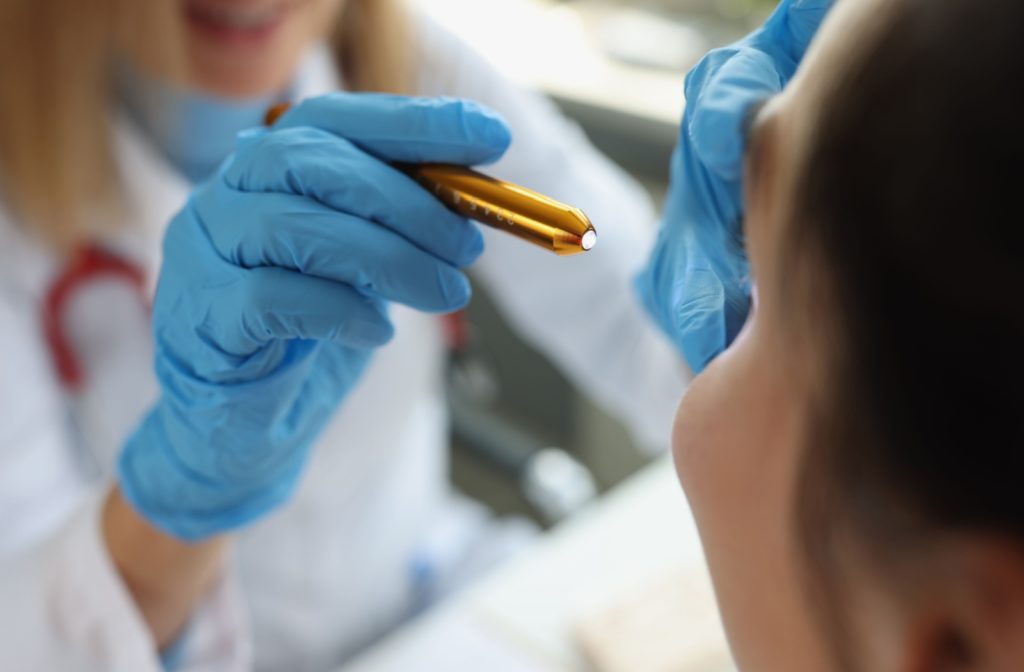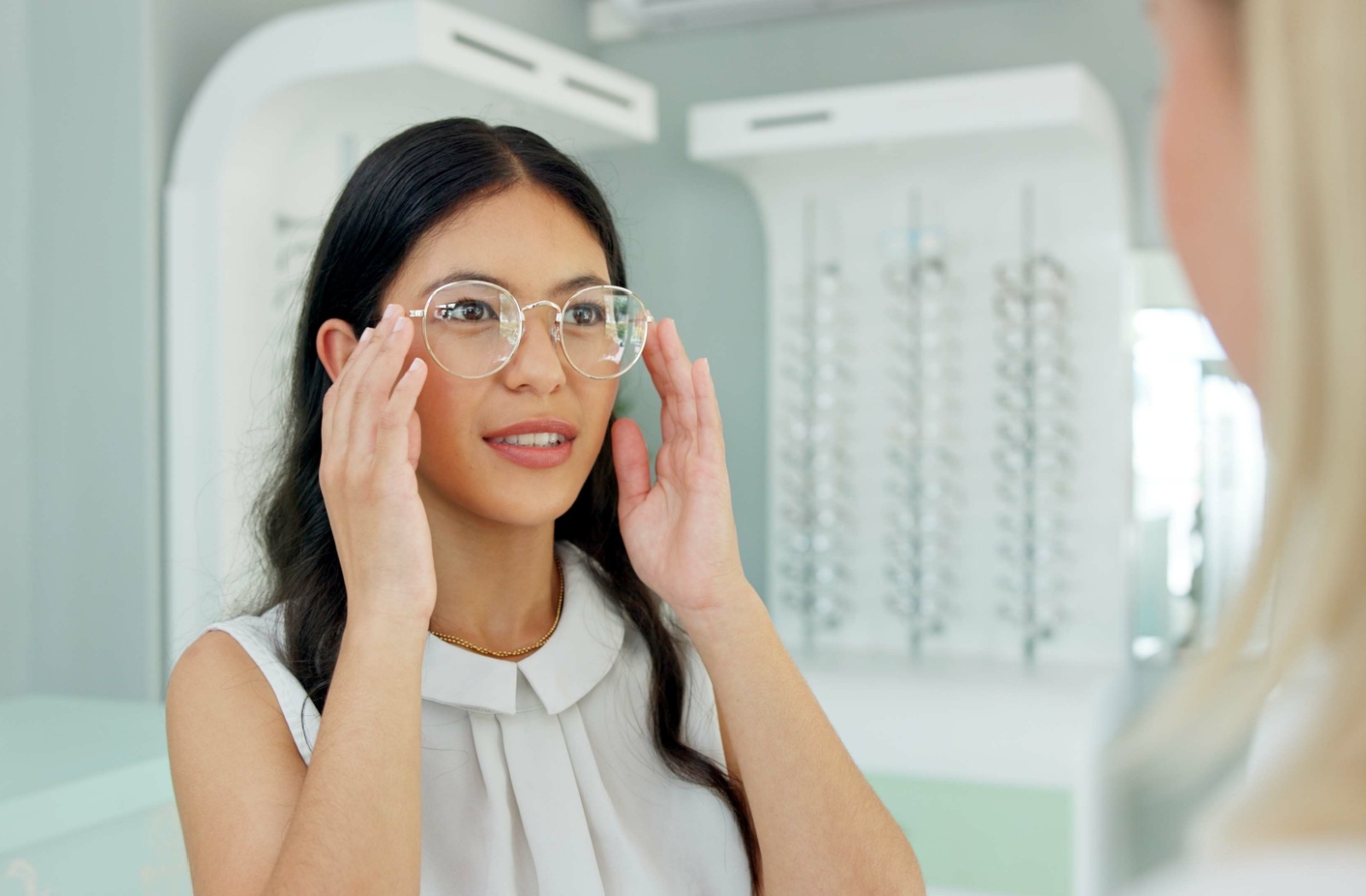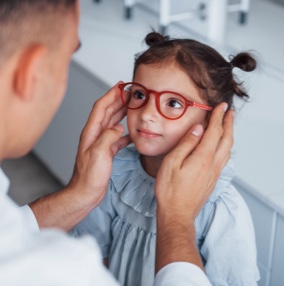Accidents can happen suddenly, including to your eyes and vision. Knowing when to seek urgent care helps preserve your eyesight and can be as simple as visiting your optometrist.
You should see an eye doctor as soon as possible if you experience any of the following:
- Eye injuries
- Contact-lens complications
- Severe eye pain
- Swelling near the eyes
- Sudden changes in vision
- Persistent red eyes
- Eye discharge
Eye emergencies can snowball quickly and lead to severe complications or irreparable damage if left unchecked. Always prioritize your eye health by visiting your eye doctor immediately.
Eye Injuries
Eye injuries can vary from mild to severe. They can lead to long-term damage or vision loss if not quickly addressed. Eye injuries can include:
- A chemical splash: This can cause severe burns to the cornea, potentially impairing vision.
- Blunt force trauma: Being struck in the eye can result in conditions like a detached retina, uveitis, or orbital fracture, which require immediate care to prevent further complications.
- Foreign objects in your eye: Debris like sand, dust, metal shavings, or wood splinters can irritate or scratch the cornea, leading to a corneal abrasion. If the object is not removed promptly or improperly handled, it may cause infection or further damage.
Accidents can happen unexpectedly, but wearing appropriate protective eyewear, whether it’s goggles in the lab or sports-specific gear like face shields or helmets can help reduce the risk of eye injuries.
Contact Lens Complications
Improper contact lens wear and care can increase the likelihood of contact lens-related eye complications, such as:
- Redness or irritation: Sudden redness and discomfort during wear may signal an underlying concern.
- Blurry vision: Sudden blurry vision during wear or after removing them, may be a sign of a corneal infection.
- Foreign body sensation: Feeling as though there’s something stuck in your eye, even after removing your lenses, might point to a corneal abrasion.
- Signs of infection: Swelling, redness, discharge, or a burning sensation after wearing your lenses.
- Lenses feel stuck or won’t come out: Avoid using excessive force if your lenses feel stuck or won’t come out. This can harm and further irritate your eyes. Visit your eye doctor for safe removal.
Without proper intervention and intervention from your eye doctor, these signs and symptoms can quickly escalate and increase your risk of corneal complications.
Avoid wearing your contacts if your eyes feel irritation or discomfort (unless they’re stuck). Give your eyes a break, and in the meantime, wear your eyeglasses until your optometrist has given the green light to wear a fresh new pair of lenses again.
Severe Eye Pain
Dry or tired eyes can lead to mild discomfort but experiencing severe eye pain goes beyond relatively common eye conditions. Severe eye pain is not normal. It’s often described as a sharp, constant, or throbbing pain that doesn’t improve on its own.
This symptom is considered an eye emergency because it’s associated with serious eye conditions that require immediate care, such as:
- Uveitis
- Scleritis
- Acute angle-closure glaucoma
- A foreign object embedded in the eye
- Corneal ulcers or infections
Severe eye pain is generally accompanied by other symptoms, such as:
- Sensitivity to light
- Blurry vision
- Headaches or nausea
- Redness
- Discharge
- Swelling
A visit to your optometrist helps identify the underlying cause of this symptom. Once the source is determined, they’ll recommend treatment options such as medications, prescription eye drops, or a referral to a specialist if necessary.
Swelling Near the Eyes
In the spring, allergies become more present and may cause swelling around the eyes to occur. However, if you notice tenderness or redness, or can’t fully open your eye because of the swelling, make it a priority to visit your optometrist.
Swelling near the eyes can develop for a few reasons, including:
- Infections: Inflammatory conditions like orbital cellulitis, affects tissues surrounding the eye. Leaving infections untreated can spread and lead to serious complications, including vision loss.
- Eye injuries: Trauma to the eye and surrounding area can also lead to swelling that requires immediate attention to verify the eye’s health.

Sudden Changes in Vision
Experiencing sudden changes in your vision shouldn’t be ignored, as they may indicate an underlying condition.
Some symptoms of sudden visual changes include:
- Flashes of light: These are bursts of light or colours in your vision. If flashes appear suddenly, this could be a sign of a retinal detachment, a condition where the retina pulls away from its supportive tissue.
- Floaters: These can appear as specks, lines, or dark shapes moving across your field of vision. Sometimes, these are harmless however, an influx of new floaters could be a warning of retinal tears or bleeding in the eye.
- Halos around lights: Seeing halos, especially at night, may signal glaucoma, a condition that damages the optic nerve due to increased eye pressure or points to nerve damage, strokes, or other neurological issues.
- Sudden blurry or fluctuating vision: Sudden visual changes can be a symptom of serious problems like diabetes-related eye disease, macula-related eye disease, glaucoma, or even a stroke.
These sudden visual changes don’t improve on their own. Ignoring changes to your eye might give seemingly manageable concerns time to progress into permanent vision loss.
Persistent Red Eyes
Although occasional redness can develop from minor irritations like allergies or dry eyes, persistent redness accompanied by symptoms such as pain, discharge, or blurry vision, may indicate a more serious concern.
Here’s why persistent red eyes shouldn’t be ignored:
- Potential for serious eye conditions: A warning sign of conditions like uveitis, keratitis, or scleritis, which are inflammatory diseases that, if left untreated, can harm your vision. Redness might also point to an infection such as a corneal ulcer.
- Risk of eye damage: If redness is accompanied by pain or vision changes, it could mean the eye is under significant stress or injury. Conditions such as glaucoma, often include redness as an early symptom.
- Possible signs of systemic health problems: Red eyes are occasionally linked to systemic health issues, such as autoimmune disorders, thyroid eye disease, vascular conditions, or infections that affect various parts of the body.
Eye Discharge
Eye discharge can sometimes develop from minor eye conditions, but the underlying condition may be more severe if the discharge appears:
- Excessive
- Changes in colour
- Accompanied by redness and discomfort
These symptoms may be a sign of allergic, bacterial, or viral conjunctivitis or even a more severe infection such as a corneal ulcer.
If you’re dealing with thick, yellow, or green discharge that doesn’t clear up, it’s time to contact your optometrist for a thorough evaluation.
Skip the Walk-in and Pharmacist–Opt for an Optometrist
Optometrists have the proper tools and equipment to evaluate, diagnose, and manage ocular complications. Don’t wait for a potential emergency to worsen and visit your eye doctor immediately. The health of your eyes and vision should come first.
Although people don’t always prioritize emergency care in their hectic schedules, eye emergencies can happen suddenly. If you require urgent care outside of our business hours, please visit your nearest emergency room or walk-in clinic. If you’re unsure whether your symptoms require immediate attention, please don’t hesitate to contact our Clarity Optometry & Vision Care team for further information. We have dedicated daily appointments to accommodate for ocular emergencies.

























